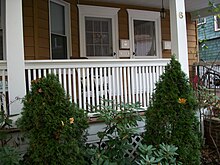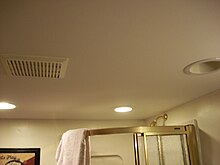- By Paul Kerr
- In Uncategorized
Home repair Company in Charlotte NC 704-614-3420 Call 1 Home Services
Home repair Company in Charlotte NC 704-614-3420 Call 1 Home Services
Home repair involves the diagnosis and resolution of problems in a home, and is related to home maintenance to avoid such problems. Many types of repairs are “do it yourself” (DIY) projects, while others may be so complicated, time-consuming or risky as to suggest the assistance of a qualified handyman, property manager, contractor/builder, or other professionals. Repair is not necessarily the same as home improvement, although many improvements can result from repairs or maintenance. Often the costs of larger repairs will justify the alternative of investment in full-scale improvements. It may make just as much sense to upgrade a home system (with an improved one) as to repair it or incur ever-more-frequent and expensive maintenance for an inefficient, obsolete or dying system. For a DIY project, it is also useful to establish limits on how much time and money you’re willing to invest before deciding a repair (or list of repairs) is overwhelming and discouraging, and less likely to ever be completed.
Worn, consumed, dull, dirty, clogged
Repairs often mean simple replacement of worn or used components intended to be periodically renewed by a homeowner, such as burnt out light bulbs, worn out batteries, or overfilled vacuum cleaner bags. Another class of home repairs relates to restoring something to a useful condition, such as sharpening tools or utensils, replacing leaky faucet washers, cleaning out plumbing traps, rain gutters. Because of the required precision, specialized tools, or hazards, some of these are best left to experts such as a plumber. One emergency repair that may be necessary in this area is overflowing toilets. Most of them have a shutoff valve on a pipe beneath or behind them so that the water supply can be turned off while repairs are made, either by removing a clog or repairing a broken mechanism.
Broken or damaged
Perhaps the most perplexing repairs facing a homeowner are broken or damaged things. In today’s era of built-in obsolescence for many products, it is often more convenient to replace something rather than attempt to repair it. A repairman is faced with the tasks of accurately identifying the problem, then finding the materials, supplies, tools and skills necessary to sufficiently effect the repair. Some things, such as broken windows, appliances or furniture can be carried to a repair shop, but there are many repairs that can be performed easily enough, such as patching holes in plaster and drywall, cleaning stains, repairing cracked windows and their screens, or replacing a broken electrical switch or outlet. Other repairs may have some urgency, such as a broken water pipes, broken doors, latches or windows, or a leaky roof or water tank, and this factor can certainly justify calling for professional help. A home handyman may become adept at dealing with such immediate repairs, to avoid further damage or loss, until a professional can be summoned. For HVAC repairs in NC, view service areas.
Maintenance
Periodic maintenance also falls under the general class of home repairs. These are inspections, adjustments, cleanings, or replacements that should be done regularly to ensure proper functioning of all the systems in a house, and to avoid costly emergencies. Examples include annual testing and adjustment of alarm systems, central heating or cooling systems (electrodes, thermocouples, and fuel filters), replacement of water treatment components or air-handling filters, purging of heating radiators and water tanks, defrosting a freezer, vacuuming refrigerator coils, refilling dry floor-drain traps with water, cleaning out rain gutters, downspouts and drains, touching up worn house paint and weather seals, and cleaning accumulated creosote out of chimney flues, which may be best left to a chimney sweep.
Examples of less frequent home maintenance that should be regularly forecast and budgeted include repainting or staining outdoor wood or metal, repainting masonry, waterproofing masonry, cleaning out septic systems, replacing sacrificial electrodes in water heaters, replacing old washing machine hoses (preferably with stainless steel hoses less likely to burst and cause a flood), and other home improvements such as replacement of obsolete or aging systems with limited useful lifetimes (water heaters, wood stoves, pumps, and asphaltic or wooden roof shingles and siding. If your stove is in need of repair and you are not in the general area to receive our services, you will need to research a Stove Repair service that can help you out.
Often on the bottom of people’s to-do list is home maintenance chores, such as landscaping, window and gutter cleaning, power washing the siding and hard-scape, etc. Nick from nickswindowcleaning.ca says “gutter cleaning is important“. Neglecting these chores can give yourself a bigger headache down the line and these maintenance chores pay for themselves. Often, injury could occur when operating heavy machinery or when climbing on ladders or roofs around your home, so if an individual is not in the proper physical condition to accomplish these chores, then they should consult a professional. Lack of maintenance will cost more due to higher costs associated with repairs or replacements to be made later. It requires discipline and learning aptitude to repair and maintain the home in good condition, but it is a satisfying experience to perform even seemingly minor repairs.
Good operations
Another related issue for avoiding costly repairs (or disasters) is the proper operation of a home, including systems and appliances, in a way that prevents damage or prolongs their usefulness. For example, at higher latitudes, even a clean rain gutter can suddenly build up an ice dam in winter, forcing melt water into unprotected roofing, resulting in leaks or even flooding inside walls or rooms. This can be prevented by installing moisture barrier beneath the roofing tiles. A wary homeowner should be alert to the conditions that can result in larger problems and take remedial action before damage or injury occurs. This should be checked if the homeowner is looking into installing one of these skylights for residential homes into their home. It may be easier to tack down a bit of worn carpet than repair a large patch damaged by prolonged misuse. Another example is to seek out the source of unusual noises or smells when mechanical, electrical or plumbing systems are operatingsometimes they indicate incipient problems. One should avoid overloading or otherwise misusing systems, and a recurring overload may indicate time for an upgrade.
Water infiltration is one of the most insidious sources of home damage. Small leaks can lead to water stains, and rotting wood. Soft, rotten wood is an inviting target for termites and other wood-damaging insects. Left unattended, a small leak can lead to significant structural damage, necessitating the replacement of beams and framing.
With a useful selection of tools, typical materials and supplies on hand, and some home repair information or experience, a homeowner or handyman should be able to carry out a large number of DIY home repairs and identify those that will need the specialized attention of others.
Remediation of environmental problems
When a home is sold, inspections are performed that may reveal environmental hazards such as radon gas in the basement or water supply or friable asbestos materials (both of which can cause lung cancer), peeling or disturbed lead paint (a risk to children and pregnant women), inground heating oil tanks that may contaminate ground water, or mold that can cause problems for those with asthma or allergies. Typically the buyer or mortgage lender will require these conditions to be repaired before allowing the purchase to close. An entire industry of environmental remediation contractors has developed to help home owners resolve these types of problems.
What is a Hanyman ??
A handyman is a person skilled at a wide range of repairs, typically around the home. These tasks include trade skills, repair work, maintenance work, both interior and exterior, and are sometimes described as “odd jobs”, “fix-up tasks”, and include light plumbing jobs such as fixing a leaky toilet or light electric jobs such as changing a light fixture.
The term handyman increasingly describes a paid worker, but it also includes non-paid homeowners or do-it-yourselfers. Tasks range from minor to major, from unskilled to highly skilled, and include painting, drywall repair, remodeling, minor plumbing work, minor electrical work, household carpentry, sheetrock, crown moulding, and furniture assembly (see more complete list below.) The termhandyman is occasionally applied as an adjective to describe politicians or business leaders who make substantial organizational changes, such as overhauling a business structure or administrative division.[1][2]
Many people can do common household repairs. There are resources on the Internet, as well as do-it-yourself guide books,[3] with instructions about how to complete a wide range of projects. Sometimes the fix-it skill is seen as genetic, and people lacking such skills are said to “lack the handy-man gene.”[4] One trend is that fewer homeowners are inclined to do fix-up jobs, perhaps because of time constraints, perhaps because of lack of interest; one reporter commented “my family’s fix-it gene petered out before it reached my generation.”[5] A primary rule for all do-it-yourself repair work is focus entirely on one thing at a time.[6] For example, focus on getting a nail; then focus on hammering the nail; but don’t try to do both tasks simultaneously. In this manner, injuries and mistakes are avoided.
Generally the job of paid handyman is low status, a semi-skilled labor job. It’s a less prestigious occupation than a specialist such as a plumber, electrician, or carpenter. With the emergence of large national chains, and effort is being made to change that perception, by emphasizing professionalism and the fact that a handyman is actually a technician with multiple skills and a wide range of knowledge. At the same time, unpaid homeowners skilled at repairs are valued for saving money. And handyman tools sometimes become useful in different places: for example, when a proper neurological drill was not available, an Australian doctor used a handyman’s drill in 2009 to open a hole in the head of a 13-year old boy to relieve pressure after a brain injury; the boy’s life was saved
Market estimates
An estimate was that in 2003, the market for home-maintenance and repair spending was up 14% from 2001 to 2003.[8] Another estimate was that the market in the United States was $126 billion and was increasing by about 4% annually.[5] American homes are aging; one estimate was that in 2007, more than half of all homes are older than 25 years.[8] And, as populations worldwide tend to become older, on average, and since increasingly elderly people will be less inclined and able to maintain their homes, it is likely that demand for handyman services will grow
Independent operators
Many towns have handymen who work part-time, for friends or family or neighbors, who are skilled in a variety of tasks. Sometimes they advertise in newspapers or online. They vary in quality, professionalism, skill level, and price. Contractors often criticize the work of previous contractors, and this practice is not limited to handymen, but to all trades.[9] Handymen have advertised their services through flyers and mailings; in addition, free websites such as Craigslist and SkillSlate help customers and handymen find each other.[10]
Franchise businesses
In 2009, there were national handyman service firms which handle such nationwide tasks as public relations, marketing, advertising, and signage, but sell specific territories to franchise owners. A franchise contract typically gives a franchise owner the exclusive right to take service calls within a given geographical area. The websites of these firms put possible customers in touch with local owners, which have handypersons and trucks. Customers call the local numbers. Typically these firms charge around $100/hour, although fees vary by locality and time of year. In many parts of the world, there are professional handyman firms that do small home or commercial projects which claim possible advantages such as having workers who are insured and licensed. Their branch offices schedule service appointments for full-time and part-time handymen to visit and make repairs, and sometimes coordinate with sub-contractors.
One Lehman Brothers executive, after being let go from the Wall Street firm, bought a Union, New Jersey franchise from a national handyman firm.[11] A franchise was approximately $110,000 with a franchise fee of $14,900, according to a spokesperson for a national handyman franchise.[11]
Some see a benefit of franchising as “entrepreneurship under the safety net of a tried-and-true business umbrella”[11] but forecast a 1.2 percent decrease in franchise businesses during the 2008-2009 recession.[11] In 2005, according to a survey released by the Washington-based International Franchise Association showed 909,000 franchised establishments in the United States employing some 11 million people.[11] Franchises offer training, advertising and information technology support, lower procurement costs and access to a network of established operators.[11]
Franchise handyman firms sometimes pitch clients by asking prospective customers about their unresolved “to-do lists.”[12] The firm does odd jobs,carpentry, and repairs.[12] Trends such as a “poverty of time” and a “glut of unhandy husbands” has spurred the business.[12] Technicians do a range of services including tile work, painting, and wallpapering.[12] One firm charges $88 per hour.[12] The firm targets a work category which full-fledged remodelers and contractors find unprofitable.[12] A consumer was quoted by a reporter explaining the decision to hire one firm: “‘I couldn’t find anyone to come in and help me because the jobs were too small’, said Meg Beck of Huntington, who needed some painting and carpentry done. She turned to one franchise firm and said she liked the fact that the service has well-marked trucks and uniformed technicians and that a dispatcher called with the names of the crew before they showed up.”[12] There are indications that these businesses are growing.[12] There are different firms operating.[8][13]
Other competitors include online referral services.[5] In addition, some large home centers offer installation services for products such as cabinets and carpet installation.[12] Sometimes homeowners contact a professional service after trying, but failing, to do repair work themselves; in one instance, aMinneapolis homeowner attempted a project but called a technician to finish the project, and the overall cost was substantial.[14]
Assessment of handyman options
How well do the franchise chains perform? One Wall Street Journal reporting team did an informal assessment by hiring “handymen all over the country and asked them to fix a wide range of problems, from a relatively routine leaky faucet to a sticky door.”[8] The reporter concluded that “with few licensing requirements and standards for the industry, prices are all over the board.”[8] One quote was ten times as large as another.[8] Further, the reporter concluded “A big corporate name is no guarantee of quality or speedy service.”[8] One corporate firm took three weeks to fix a stuck door.[8] Service varied from spotty to good, with complaints about unreturned phone calls, service people standing on dining room chairs, leaving holes between wood planking, but liked getting multiple jobs done instead of just one.[8] Customers liked handymen wearing hospital booties (to avoid tracking dirt in houses).[8] The reporter chronicled one experience with repairing a water-damaged ceiling. A franchise firm fixed it for $1,530; a second (non-franchise local handyman) fixed a similar ceiling for $125.[8] The reporter preferred the second worker, despite the fact that he “doesn’t have a fancy van — or carry proof of insurance.”[8] Tips for selecting a good handyman include: ask questions, get written estimates on company stationery, make sure handymen guarantee their work, pay with credit cards or checks because this provides an additional record of each transaction, check references and licenses, and review feedback about the contractors from Internet sites.[15]
Legal issues
Generally, in the United States, there are few legal issues if an unpaid homeowner works on a project within their own home, with some exceptions. Some jurisdictions require paid handypeople to be licensed and/or insured. New Jersey, for example, requires all handymen who work in for-profit businesses serving residential and commercial customers, to be registered and insured.[16] Often handymen are barred from major plumbing, electrical wiring, or gas-fitting projects for safety reasons, and authorities sometimes require workers to be licensed in particular trades. However, minor plumbing work such as fixing water taps, connecting sinks, fixing leaks, or installing new washing machines, are usually permitted to be done without licensing. Many handymen are insured under a property damage liability policy, so that accidental property damage from negligence or accidents are covered.
Distinction between handyman and general contractor
It is generally assumed that a handyman, being a jack of many trades, performs the work himself. The general contractor,[17] on the other hand, hires more specialized subcontractors[18] (or handymen) to perform some or all of the construction work.
Handymen in popular culture
The handyman image recurs in popular culture. There have been songs about handymen recorded by Elvis Presley in 1964, Del Shannon in 1964, James Taylor in 1977.[19] There are femme-fatale TV characters who fall for handymen.[20]Handymen have been portrayed in books and films, generally positively, as do-gooder helpful types, but not particularly smart or ambitious. In a book by author Carolyn See called The Handyman, a handyman is really an aspiring but discouraged artist who transforms the lives of people he works for, as well as sleeping with some of his clients, and his experiences improve his artistic output.[21] The book suggests handymen discover “the appalling loneliness of the women who call him for help” whose needs are sometimes “comic,” sometimes “heartbreaking,” and deep down “sexual.”[22] A 1980 movie called The Handyman was about a carpenter-plumber who was “good at what he does” but is “too honest and trusting”, and gets taken advantage of by “women who find him handsome and understanding;” the movie earned negative reviews from critic Vincent Canby.[23] Other movies have used a rather tired formula of sexy-handyman meets bored-housewives, such as The Ups and Downs of a Handyman, a 1975 movie in which “Handsome Bob also finds he’s a fast favorite with the local housewives, who seem to have more than small repairs on their minds.”[24] In Canada, there’s a television show called Canada’s Worst Handyman which is a reality-show in which handyman contestants try their best on jobs in order to not be labeled worst handyman. Home Improvement was an American television sitcom starring Tim Allen, which aired 1991 to 1999. Handy Manny is an American/Hispanic preschool television show that air’s on Disney Junior and stars a handy man cartoon character named Manny.
List of handyman jobs
The list of projects which handymen can do is extensive, and varies from easy-to-learn tasks which take little time such as changing a light bulb, to extensive projects which require multiple steps, such as kitchen remodeling. Here is a partial list:
|
|
|












